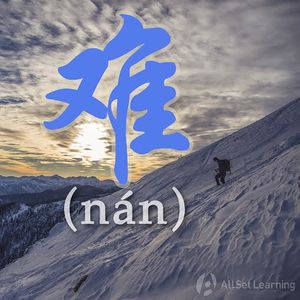Difference between revisions of "Expressing "difficult" with "nan""
Yangrenjun (talk | contribs) |
ViktorMugli (talk | contribs) |
||
| Line 32: | Line 32: | ||
[[Category:A2 grammar points]] | [[Category:A2 grammar points]] | ||
| + | {{Used for|Describing Actions}} | ||
{{Basic Grammar|难|A2|难 + V|<em>难</em> 做。<em>难</em> 买。|grammar point|ASG35T4H}} | {{Basic Grammar|难|A2|难 + V|<em>难</em> 做。<em>难</em> 买。|grammar point|ASG35T4H}} | ||
{{Similar|Easy to do something}} | {{Similar|Easy to do something}} | ||
{{Similar|Expressing Difficulty with "hao (bu) rongyi"}} | {{Similar|Expressing Difficulty with "hao (bu) rongyi"}} | ||
Revision as of 09:59, 13 June 2012
-
Level
-
Similar to
-
Used for
-
Keywords
Structure
Just as 好 can be used to indicate that it's easy to do something, 难 (nán) can be attached to verbs to indicate that something is hard to do or bad to do. The structure is:
难 + Verb
Examples
- 难懂
- 难学
- 难做
- 难买
See also
Sources and further reading
Books
- Integrated Chinese: Level 1, Part 2 (pp. 233) →buy



